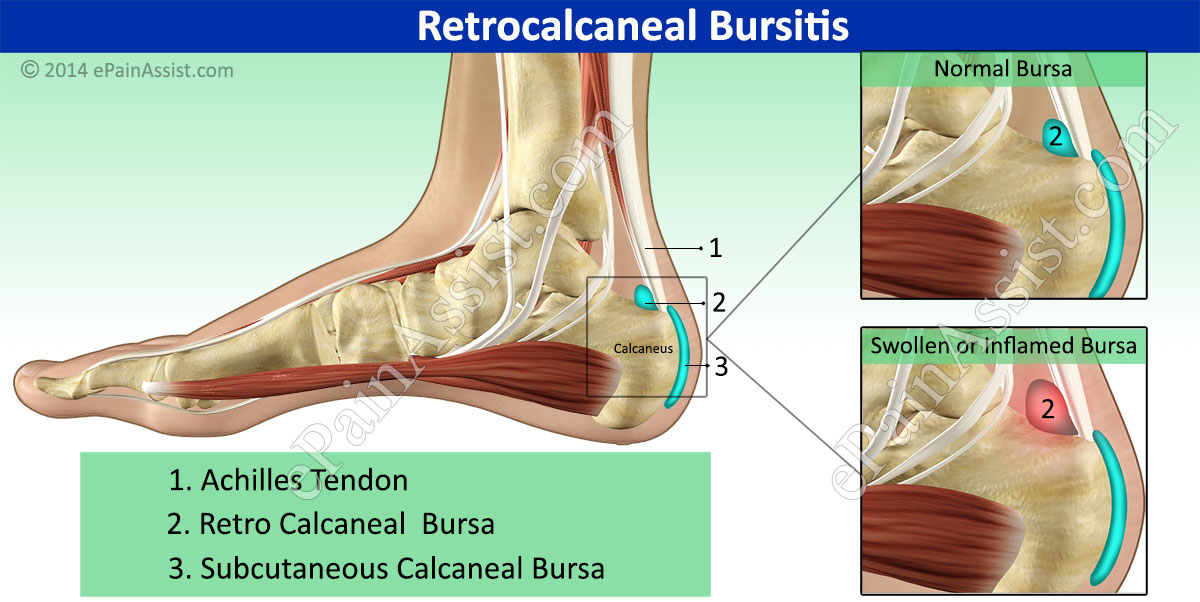What is Retrocalcaneal Bursitis or Achilles Tendon Bursitis?
Retrocalcaneal Bursitis is also known as Achilles Tendon Bursitis. It is a condition where there is inflammation of the bursa of the Achilles tendon causing foot pain. Retrocalcaneal Bursitis or Achilles Tendon Bursitis is common in athletes, especially in runners. This condition may be incorrectly diagnosed as Achilles tendonitis or it may also occur along with Achilles tendonitis.
A bursa is a small sac filled with fluid and lined with synovial membrane. It is located between a tendon and a bone. It allows smooth movement of the tendon over the bone. The retrocalcaneal bursa is located in the feet between the calcaneus (heel bone) and the Achilles tendon. Inflammation of this bursa is due to repeated trauma or overuse.

Causes of Retrocalcaneal Bursitis or Achilles Tendon Bursitis
- Wearing ill fitting or high heeled footwear can cause Retrocalcaneal Bursitis or Achilles Tendon Bursitis.
- Achilles Tendon Bursitis can also be caused due to repeated injury or overuse of the tendon.
- People having flatfeet maybe more prone to developing Retrocalcaneal Bursitis.
- Surface on which an athlete trains on also can be a factor for developing bursitis of the Achilles tendon.
- Being overweight and lack of fitness can predispose a person to developing Retrocalcaneal Bursitis or Achilles Tendon Bursitis.
- Bursitis of the Achilles tendon is more commonly caused among runners.
- Exercising without properly warming up first can also be a factor in developing this condition.

Symptoms of Retrocalcaneal Bursitis or Achilles Tendon Bursitis
- Pain posterior to the heels, particularly when running uphill or on soft planes can be a symptom of Retrocalcaneal Bursitis or Achilles Tendon Bursitis.
- Swelling is present which may make wearing certain footwear difficult.
- A soggy resistance can be felt upon pressing on both sides of the heel in people suffering from Achilles Tendon Bursitis.

Diagnosis of Retrocalcaneal Bursitis or Achilles Tendon Bursitis
A sports medicine specialist or physiotherapist can arrive at a diagnosis of Retrocalcaneal Bursitis or Achilles Tendon Bursitis based up subjective and objective evaluation as well as diagnostic studies like MRI, CT, and Ultrasound.
Treatment of Retrocalcaneal Bursitis or Achilles Tendon Bursitis
- Rest is very important to treat and recover from Retrocalcaneal Bursitis or Achilles Tendon Bursitis.
- Cold therapy or ice application is an effective conservative treatment for Retrocalcaneal Bursitis or Achilles Tendon Bursitis.
- Patient suffering from Retrocalcaneal bursitis should seek consultation of a sports injury professional.
- Anti-inflammatory medications such as ibuprofen and naproxen help in pain and inflammation associated with bursitis of the Achilles tendon.
- Ultrasound treatment is also beneficial for bursitis of the Achilles tendon.
- Steroid injection can be given to relieve pain associated with Retrocalcaneal Bursitis or Achilles Tendon Bursitis.
- Compression bandages.
- Choice of the right footwear can be very important.
- Massage can he helpful in loosening up the muscles around the affected joint.
- Proper stretches and exercises play an important role in the treatment of Retrocalcaneal Bursitis or Achilles Tendon Bursitis.
- In severe cases, the surgery may be required to treat this condition.
Stretching Exercises for Retrocalcaneal Bursitis or Achilles Tendon Bursitis
It is advised that the patient seek medical advice before starting any exercises for Retrocalcaneal Bursitis or Achilles Tendon Bursitis.
Gastrocnemius Muscle Stretching Exercise for Retrocalcaneal Bursitis or Achilles Tendon Bursitis
- Stand with the legs spread apart.
- The heel of the back leg should be positioned on the floor with the knee straight.
- The front knee should be bent forwards along with leaning forwards and pushing against a wall if necessary.
- This stretch should be held for 10 seconds.
- Repeat three to five times for thrice a day.
- Increase the duration of the stretch gradually (up to 45 seconds).

Soleus Muscle Stretching Exercise for Retrocalcaneal Bursitis or Achilles Tendon Bursitis
The same method as above should be followed, but the stretching leg should be flexed at the knee. This excludes Gastrocnemius muscle attaching above the knee from the stretch.

Stretching on a Step
- To do this exercise for Retrocalcaneal bursitis or Achilles tendon bursitis, stand on the border of a step with the heel hanging and stretch.
- A gentle stretch can be felt. Hold this position for minimum 15 seconds.
- Do not over-do this stretch.

Recovery Period for Retrocalcaneal Bursitis or Achilles Tendon Bursitis
Physiotherapy helps in complete recovery from Retrocalcaneal Bursitis or Achilles Tendon Bursitis. People suffering from minor severity of Retrocalcaneal Bursitis usually recover within few weeks. But, in case if the severity of the bursitis of the Achilles tendon is more or has been present for sometime then the recovery period may extend to a couple of months. It is advisable to get the problem diagnosed soon followed by early treatment in order to recover soon from the Retrocalcaneal Bursitis or Achilles Tendon Bursitis soon.
Also Read:
- Ankle Joint Bursitis: Causes, Symptoms, Treatment-Conservative, PT, NSAIDs, Surgery
- Bursitis: Shoulder, Hip, Ankle, Prepatellar, Retrocalcaneal, Subacromial, Ischial, Wrist, Iliopsoas
Also Watch Video:
